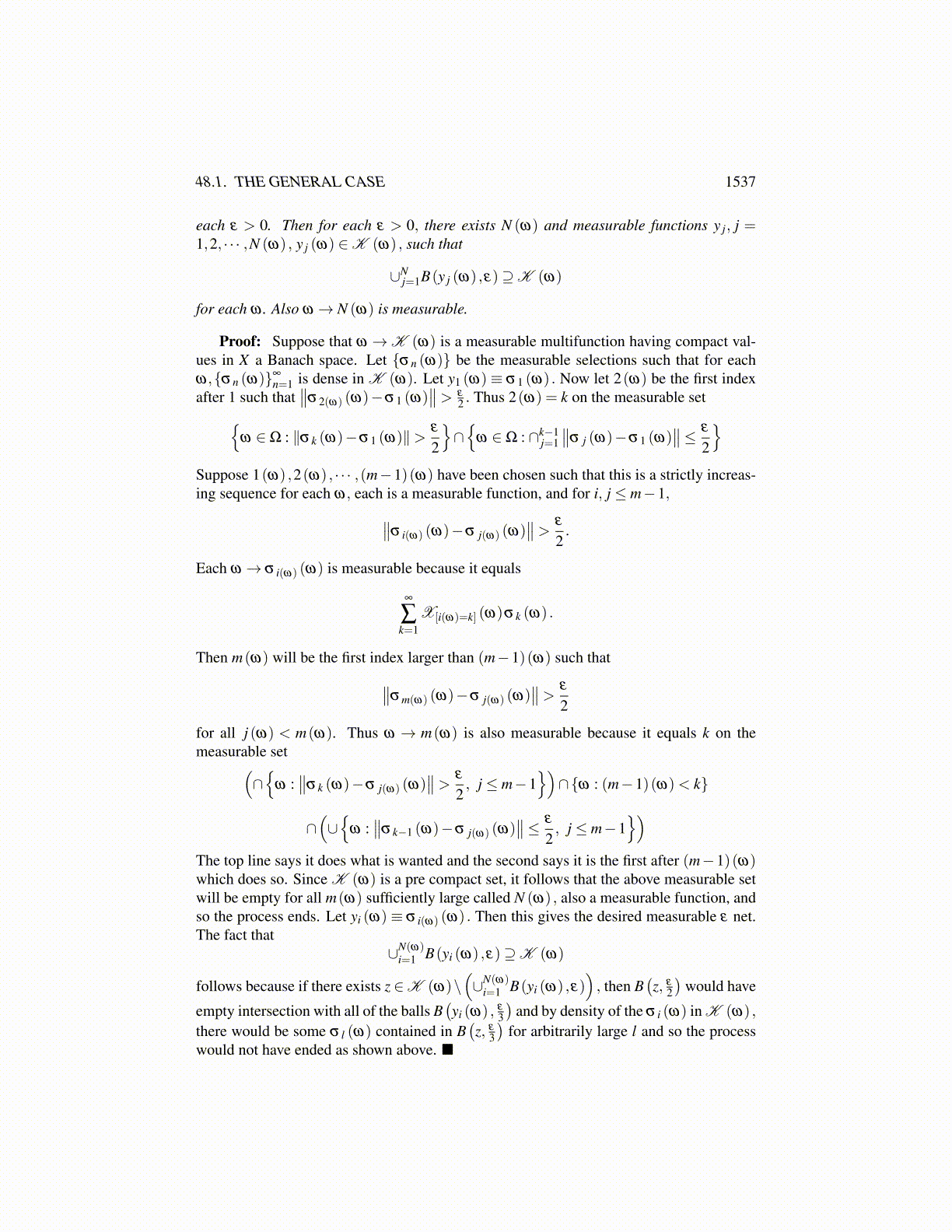
48.1. THE GENERAL CASE 1537
[{ω : Γ(ω)∩B
(xn,2−i)= /0
}∩{ω : Γ(ω)∩U ̸= /0}
]={
ω : Γ(ω)∩B(xn,2−i)∩U ̸= /0
}∪[(
Ω\{
ω : Γ(ω)∩B(xn,2−i) ̸= /0
})∩{ω : Γ(ω)∩U ̸= /0}
],
a measurable set. By what was just shown, there exists σni, a measurable function suchthat σni (ω) ∈ Γni (ω)⊆ Γ(ω) for all ω ∈Ω. If x ∈ Γ(ω), then
x ∈ B(
xn,2−(i+2))
whenever xn is close enough to x. Thus both x,σn(i+2) (ω) are in B(
xn,2−(i+2))
and so∣∣σn(i+1) (ω)− x∣∣< 2−i. It follows that condition 2.) holds. Note that this had nothing to do
with a measure.Now consider why 2.)⇒ 1.). We have {σn (ω)} ⊆ Γ(ω) and σn is measurable and
∪nσn (ω) equals Γ(ω). Why is Γ a measurable multifunction? Let U be an open set
Γ− (U) ≡ {ω : Γ(ω)∩U ̸= /0}
={
ω : Γ(ω)∩U ̸= /0}
= ∪nσ−1n (U) ∈ C
For much more on multifunctions, you should see the book by Hu and Papageorgiou .The above proof follows the presentation in this book.
48.1.1 A Special Case Which Is Easier
The above is a pretty long and difficult argument to show that Γ− (U) ∈ C for all U openis equivalent to Γ− (F) for all F closed. However, there is a special case for which thisis much easier to show. Suppose Γ(ω) is not just closed but is also compact. Then asabove, if Γ− (F) ∈ C for all F closed, then Γ− (U) = ∪nΓ− (Fn) where Fn is an increasingsequence of closed sets whose union is U . This follows from the observation that
Γ(ω)∩U = ∪nΓ(ω)∩Fn
and so to say the set on the left is nonempty is to say that at least one of the sets on the rightis nonempty. Thus if Γ− (F) ∈ C for all F closed, then Γ− (U) ∈ C for all U open. Thisrequires no special considerations.
Now suppose Γ(ω) is compact for every ω and that Γ− (U)∈C for every U open. Thenlet F be a closed set and let {Un} be a decreasing sequence of open sets whose intersectionequals F such that also, for all n, Un ⊇Un+1. Then
Γ(ω)∩F = ∩nΓ(ω)∩Un = ∩nΓ(ω)∩Un
Now because of compactness, the set on the left is nonempty if and only if each set on theright is also nonempty. Thus Γ− (F) =∩nΓ− (Un)∈C . Thus in this special case, it is mucheasier to see that these two conditions for measurability are equivalent. Note that there isno condition on measures or completeness or any such thing. This proves the followingproposition.